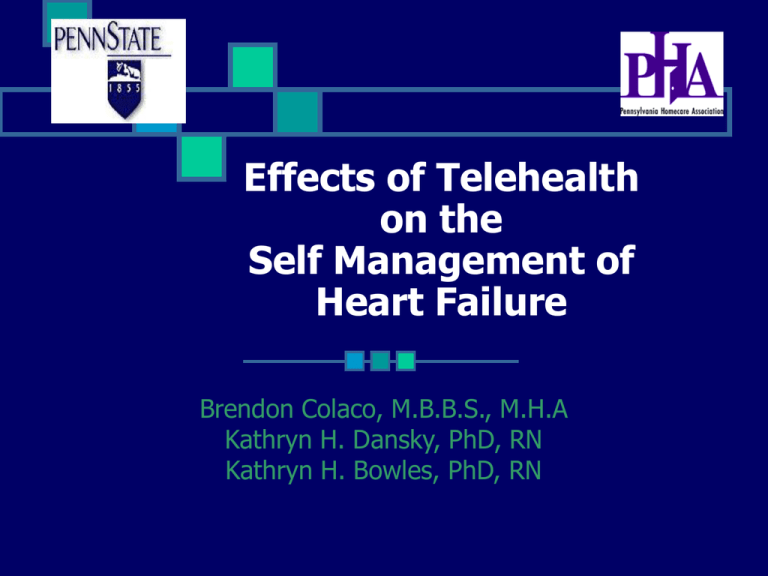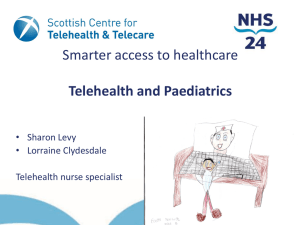Effects of Telehealth on the Self Management of Heart Failure
advertisement

Effects of Telehealth on the Self Management of Heart Failure Brendon Colaco, M.B.B.S., M.H.A Kathryn H. Dansky, PhD, RN Kathryn H. Bowles, PhD, RN Introduction Study to look at the effects of telehealth on home health patients with congestive heart failure Funded by the Robert Wood Johnson Foundation through its Health E-Technologies Initiative Study undertaken by researchers at Penn State in collaboration with the Pennsylvania Home Care Association and 10 home health agencies across the Commonwealth of Pennsylvania Telehealth Use of telecommunication technology to transmit health information over a telephone line Can transmit different types of health information such as blood pressure, pulse oximetry, blood glucose levels, heart sounds, breath sounds and in some cases a direct visualization through a camera Types of telehealth Asynchronous/ Monitor type: Transmits clinical data only. The data are collected by the machine and transmitted to a central station once a day Synchronous/ Video type: Transmits live data and video through a camera. The transmission occurs during the live event Importance of study Shift from institution centered care to patient centered care Patient involvement /participation and empowerment Preventative as opposed to therapeutic care Era of chronic conditions-need for newer modalities of disease management Healthcare costs and limitations of resources – capitol and human resources Aims of study To investigate the relationship between telehealth and patient knowledge and behaviors specifically: • knowledge of heart failure (diet, exercise and medications) • likelihood to adopt suggestions for healthy behavior • specific behaviors regarding symptom management, physical activity and diet Study Design Randomized double blinded case control study Sample o Congestive Heart Failure patients o enrolled in home health care o patient/caregiver is cognitively intact o o speaks English phone line in home Intervention Three groups Control group: regular home health care Monitor group: receives monitor type telehealth system + regular home health care Video Group: receives video type telehealth system + regular home health care Episode of home health care-60 days Survey Instruments Self Care Heart Failure Index measures specific behaviors of patients (diet, weight & activity) measures the likelihood of patients to perform healthy behaviors Responses scored on Likert scale by research assistants blinded to intervention Survey Instruments Omaha Problem Rating Scale (PRSO) measures patients’ knowledge of diet, activity, and medications All responses scored on a Likert scale by research assistants blinded to intervention Patients interviewed at baseline, 60 days and 120 days from admission to study either on the phone or via mail. Descriptive Statistics • • • • • • • • Sample: 212 patients 81 (38.2%) males 131 (61.8%) females Mean age: 77 years ( 44-96) Mean severity level for CHF:2.63 (1-4) Control Group: 85 patients Monitor Group : 90 patients Video Group: 37 patients Analyses Univariate Analyses to determine that the groups were equal at baseline Reliability analyses for various summary scores Repeated measures analyses or variance to determine the between subjects and within subjects effects over time Findings & Limitations Patients in both telehealth groups showed greater improvement over time on knowledge scores, likelihood to perform healthy behaviors and specific behaviors than the control group The time factor definitely had a significant effect There was significant change within the groups; however, the difference between the groups was not statistically significant Mean Scores Knowledge Scores 15 14.5 14 13.5 13 12.5 12 11.5 11 10.5 10 9.5 9 Control Monitor Video Baseline 60 days 120 days Time Likelihood to Perform Healthy Behaviors Means Scores 12 11. 5 11 Control 10. 5 10 Monitor 9. 5 9 8. 5 Video 8 7. 5 7 6. 5 6 Baseline 60 days Time 120 days Limitations and Challenges Findings interpreted in light of small sample size due to high attrition. Also sample not complete, therefore these are preliminary findings Difficulty in enrolling patients and getting three sets of data over 4 month period Implications & Future Direction Telehealth an effective intervention through knowledge and behavior? Is one type of system better than the other, does it vary with patient characteristics? Policy Implications: adopt telehealth as standard of care? Reimbursement issues: Medicare reimbursement for telehealth, insurance payers Need for a cost analyses and effect of telehealth on healthcare resources (nurse hours, hospitalizations, ER visits) Match telehealth with patient personalities and locus of control to get better results




